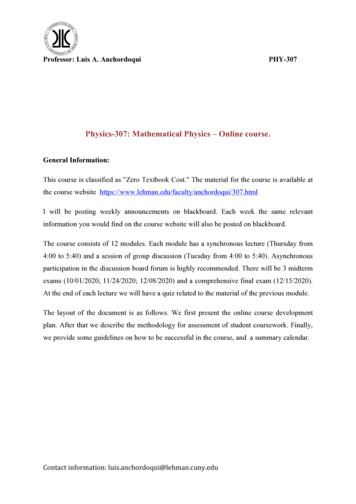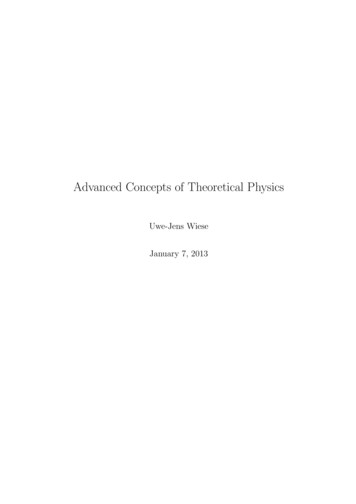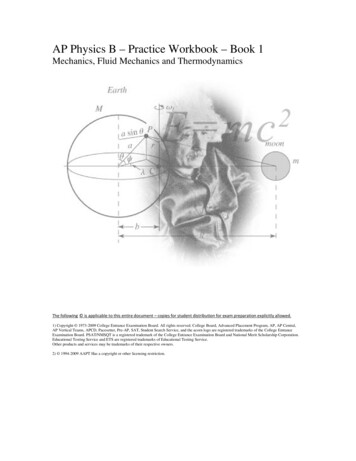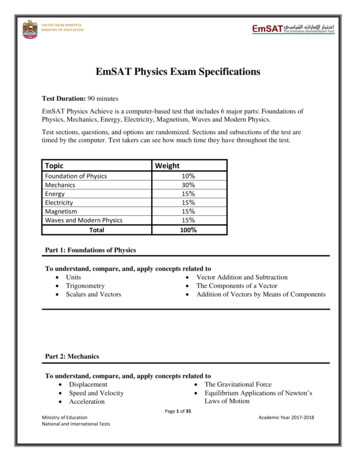
Transcription
Funky MathematicalPhysics ConceptsThe Anti-Textbook*A Work In Progress. See elmichelsen.physics.ucsd.edu/ for the latest versions of the Funky Series.Please send me comments.Eric L. MichelsenTijxvxdR TijyvyTijzvzimaginaryCRRiCICIreal-i“I study mathematics to learn how to think.I study physics to have something to think about.”“Perhaps the greatest irony of all is not that the square root of two is irrational,but that Pythagoras himself was irrational.”* Physical, conceptual, geometric, and pictorial physics that didn’t fit in your textbook.Please do NOT distribute this document. Instead, link to Please cite as: Michelsen, Eric L., Funky Mathematical Physics Concepts, elmichelsen.physics.ucsd.edu/, 4/27/2021.
elmichelsen.physics.ucsd.edu/Funky Mathematical Physics Conceptsemichels at physics.ucsd.edu2006 values from NIST. For more physical constants, see http://physics.nist.gov/cuu/Constants/ .Speed of light in vacuumc 299 792 458 m s–1 (exact)Boltzmann constantk 1.380 6504(24) x 10–23 J K–1Stefan-Boltzmann constantRelative standard uncertaintyσ 5.670 400(40) x 10–8 W m–2 K–4 7.0 x 10–6Avogadro constantRelative standard uncertaintyNA, L 6.022 141 79(30) x 1023 mol–1 5.0 x 10–8Molar gas constantR 8.314 472(15) J mol-1 K-1Electron massme 9.109 382 15(45) x 10–31 kgProton massmp 1.672 621 637(83) x 10–27 kgProton/electron mass ratiomp/me 1836.152 672 47(80)Elementary chargee 1.602 176 487(40) x 10–19 CElectron g-factorge –2.002 319 304 3622(15)Proton g-factorgp 5.585 694 713(46)Neutron g-factorgN –3.826 085 45(90)Muon massmμ 1.883 531 30(11) x 10–28 kgInverse fine structure constant –1 137.035 999 679(94)Planck constanth 6.626 068 96(33) x 10–34 J sPlanck constant over 2πħ 1.054 571 628(53) x 10–34 J sBohr radiusa0 0.529 177 208 59(36) x 10–10 mBohr magnetonμB 927.400 915(23) x 10–26 J T–1Reviews“. most excellent tensor paper. I feel I have come to a deep and abiding understanding of relativistictensors. The best explanation of tensors seen anywhere!” -- physics graduate student4/27/2021 11:49 AMCopyright 2002-2021 Eric L. Michelsen. All rights reserved.2 of 322
elmichelsen.physics.ucsd.edu/Funky Mathematical Physics Conceptsemichels at physics.ucsd.eduContents1Introduction .10Mathematical Physics, or Physical Mathematics? .10Why Physicists and Mathematicians Argue .10Why Funky? .10How to Use This Document .10Thank You.11Scope .11Notation .112Random Short Topics .14I Always Lie .14What’s Hyperbolic About Hyperbolic Sine? .14Basic Calculus You May Not Know .16The Product Rule.17Integration By Pictures .17Theoretical Importance of IBP .21Delta Function Surprise: Coordinates Matter .21Spherical Harmonics Are Not Harmonics .24The Binomial Theorem for Negative and Fractional Exponents .25When Does a Divergent Series Converge? .26Algebra Family Tree .27Convoluted Thinking .27Two Dimensional Convolution: Impulsive Behavior .28Structure Functions .29Correlation Functions .303Vectors .32Small Changes to Vectors .32Why (r, θ, ) Are Not the Components of a Vector .32Laplacian’s Place .33Vector Dot Grad Vector .414Green Functions .43The Big Idea .43Boundary Conditions on Green Functions .48Introduction to Boundary Conditions .48One Dimensional Boundary Conditions.492D? and 3D Green Functions .55Green Functions Don’t Separate .55Green Units .56Special Case: Laplacian Operator with 3D Boundary Conditions .57Desultory Green Topics .60Fourier Series Method for Green Functions .60Green-Like Methods: The Born Approximation .635Complex Analytic Functions .65Residues .66Contour Integrals .67Evaluating Integrals .67Choosing the Right Path: Which Contour? .70Evaluating Infinite Sums .75Multi-valued Functions .776Conceptual Linear Algebra .79Matrix Multiplication .79Determinants .804/27/2021 11:49 AMCopyright 2002-2021 Eric L. Michelsen. All rights reserved.3 of 322
elmichelsen.physics.ucsd.edu/Funky Mathematical Physics Conceptsemichels at physics.ucsd.eduCramer’s Rule .81Area and Volume as a Determinant .82The Jacobian Determinant and Change of Variables .83Expansion by Cofactors .85Proof That the Determinant Is Unique .87Getting Determined .88Advanced Matrices.89Getting to Home Basis .89Diagonalizing a Self-Adjoint Matrix .90Contraction of Matrices.92Trace of a Product of Matrices .92Linear Algebra Briefs .937Introduction to Probability, Statistics, and Data Analysis .94Probability and Random Variables .94Precise Statement of the Question Is Critical .95How to Lie With Statistics .96Choosing Wisely: An Informative Puzzle .96Multiple Events .97Combining Probabilities .98To B, or To Not B? .100Continuous Random Variables and Distributions .102Populations .102Population Variance .103Population Standard Deviation .103New Random Variables From Old Ones .104Some Distributions Have Infinite Variance, or Infinite Average .105Samples and Parameter Estimation .106Why Do We Use Least Squares, and Least Chi-Squared (χ2)? .106Average, Variance, and Standard Deviation .107Functions of Random Variables .111Statistically Speaking: What Is The Significance of This? .111Predictive Power: Another Way to Be Significant, but Not Important .114Unbiased vs. Maximum-Likelihood Estimators .114Correlation and Dependence .116Independent Random Variables are Uncorrelated .117r You Serious? .118Statistical Analysis Algebra .119The Average of a Sum: Easy? .119The Average of a Product.120Variance of a Sum .120Covariance Revisited .120Capabilities and Limits of the Sample Variance .121How to Do Statistical Analysis Wrong, and How to Fix It .123Introduction to Data Fitting (Curve Fitting) .124Goodness of Fit .125Guidance Counselor: Computer Code to Fit Data .1298Multiple Linear Regression .133Review of Multiple Linear Regression .133We Fit to the Predictors, Not the Independent Variable .133Homoskedastic Case: All Measurements Have the Same Uncertainty .136The Raw Sum-of-Squares Identity .137The Geometric View of a Least-Squares Fit .138Algebra and Geometry of the Sum-of-Squares Identity .140The ANOVA Sum-of-Squares Identity .140The Failure of the ANOVA Sum-of-Squares Identity.1414/27/2021 11:49 AMCopyright 2002-2021 Eric L. Michelsen. All rights reserved.4 of 322
elmichelsen.physics.ucsd.edu/Funky Mathematical Physics Conceptsemichels at physics.ucsd.eduSubtracting DC Before Analysis: Just Say No .142Fitting to Orthonormal Functions .143Hypothesis Testing with the Sum of Squares Identity .143Introduction to Analysis of Variance (ANOVA) .143The Temperature of Liberty .144The F-test: The Decider for Zero Mean Gaussian Noise .148Coefficient of Determination and Correlation Coefficient .1499Uncertainty Weighted Linear Regression .152Be Sure of Your Uncertainty .152Average of Uncertainty Weighted Data .152Variance and Standard Deviation of Uncertainty Weighted Data .154Normalized weights .156Numerically Convenient Weights .157Uncertainty Weighted Straight-Line Fit .157Transformation to Equivalent Homoskedastic Measurements .157Linear Regression with Individual Uncertainties .159Linear Regression With Uncertainties and the Sum-of-Squares Identity .160Hypothesis Testing a Model in Linear Regression with Uncertainties .16510 Practical Considerations for Data Analysis .166Rules of Thumb .166Signal to Noise Ratio (SNR) .166Computing SNR From Data .167Spectral Method of Estimating SNR .168Fitting Models To Histograms (Binned Data) .169Reducing the Effect of Noise .172Data With a Hard Cutoff: When Zero Just Isn’t Enough .174Filtering and Data Processing for Equally Spaced Samples .175Finite Impulse Response Filters (aka Rolling Filters) and Boxcars .175Use Smooth Filters (not Boxcars) .17611 Fourier Transforms and Digital Signal Processing .177Model of Digitization and Sampling .178Complex Sequences and Complex Fourier Transform .178Basis Functions and Orthogonality .181Real Sequences.182Normalization and Parseval’s Theorem .183Continuous and Discrete, Finite and Infinite .185White Noise and Correlation .185Why Oversampling Does Not Improve Signal-to-Noise Ratio .185Filters TBS? .186What Happens to a Sine Wave Deferred? .186Nonuniform Sampling and Arbitrary Basis Functions .188Don’t Pad Your Data, Even for FFTs.190Two Dimensional Fourier Transforms .191Note on Continuous Fourier Series and Uniform Convergence .191Fourier Transforms, Periodograms, and Lomb-Scargle .192The Discrete Fourier Transform vs. the Periodogram .193Practical Considerations .194The Lomb-Scargle Algorithm .195The Meaning Behind the Math .196Bandwidth Correction (aka Bandwidth Penalty) .200Analytic Signals and Hilbert Transforms .203Summary .20812 Period Finding .210Sinusoids, Fourier, Nyquist, and All That .2114/27/2021 11:49 AMCopyright 2002-2021 Eric L. Michelsen. All rights reserved.5 of 322
elmichelsen.physics.ucsd.edu/Funky Mathematical Physics Conceptsemichels at physics.ucsd.eduOverview of Period Finding Algorithms .211References .211Phase Dispersion Minimization .211PDM Algorithm .212PDM On Data With Trends .216Subharmonic Response .217Harmonic response .217Spectral window function.218References .21813 Numerical Analysis .219Round-Off Error, And How to Reduce It .219How To Extend Precision In Sums Without Using Higher Precision Variables .220Numerical Integration .221Sequences of Real Numbers .221Root Finding .221Simple Iteration Equation.221Newton-Raphson Iteration .223Pseudo-Random Numbers .226Generating Gaussian Random Numbers .227Generating Poisson Random Numbers.227Generating Useful, But More Challenging, Random Numbers .228Exact Polynomial Fits .22914 Computer Math Internals .231Digital Integer Arithmetic: Two’s Complement .231Hexadecimal.232Digital Floating Point .233How Far Can I Go? .233How Many Digits Do I Get, 6 or 9? .233How many digits do I need? .234Emulate vs. Simulate .234Programming Guidance for Floating Point .235IEEE Floating Point .236Precision in Binary and Decimal .243The Big ULP .243Round and Round .244Underflow .245References .24615 Scientific Programming: Discovering Efficiency .247Software Development Efficiency .247Some Do’s and Don’t’s .247Considerations on Development Efficiency and Languages .248Sophistication Follows Function .248Engineering vs. Programming .249Object Oriented Programming .249The B
Funky Mathematical Physics Concepts The Anti-Textbook* A Work In Progress. See elmichelsen.physics.ucsd.edu/ for the latest versions of the Funky Series. Please send me comments. Eric L. Michelsen T ijx vx T ijy vy T ijz vz dR real imaginary C I C R i-i R C I “I study mathematics to learn how to think.










